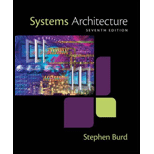
Systems Architecture
7th Edition
ISBN: 9781305080195
Author: Stephen D. Burd
Publisher: Cengage Learning
expand_more
expand_more
format_list_bulleted
Concept explainers
Expert Solution & Answer
Chapter 2, Problem 11RQ
Explanation of Solution
Classes of computer systems used for servers:
The classes of computers which are used for servers include the following:
- Midrange computer:
- Midrange computer is the smallest and least powerful server class.
- It is used for sharing smaller resources such as file systems and static web sites among hundred simultaneous users.
- Mainframe computer:
- It is larger and more powerful server class for data storage and input/output capacity...
Expert Solution & Answer
Want to see the full answer?
Check out a sample textbook solution
Students have asked these similar questions
How can I perform Laplace Transformation when using integration based on this?
Write an example of a personal reflection of your course.
- What you liked about the course.
- What you didn’t like about the course.
- Suggestions for improvement.
Course: Information and Decision Sciences (IDS)
The Reflection Paper should be 1 or 2 pages in length.
How can I perform Laplace Transformation when using integration ?
Chapter 2 Solutions
Systems Architecture
Ch. 2 - Prob. 1VECh. 2 - A(n) __________ is a storage location implemented...Ch. 2 - Prob. 3VECh. 2 - A problem-solving procedure that requires...Ch. 2 - Prob. 5VECh. 2 - Prob. 6VECh. 2 - Prob. 7VECh. 2 - Prob. 8VECh. 2 - The major components of a CPU are the __________,...Ch. 2 - A set of instructions thats executed to solve a...
Ch. 2 - Prob. 11VECh. 2 - Prob. 12VECh. 2 - Prob. 13VECh. 2 - A CPU is a(n) __________ processor capable of...Ch. 2 - Prob. 15VECh. 2 - The CPU __________ program instructions one at a...Ch. 2 - Most programs are written in a(n) __________, such...Ch. 2 - Prob. 18VECh. 2 - Prob. 19VECh. 2 - Prob. 20VECh. 2 - Prob. 21VECh. 2 - Prob. 22VECh. 2 - Prob. 23VECh. 2 - Prob. 1RQCh. 2 - What shortcomings of mechanical computation did...Ch. 2 - Prob. 3RQCh. 2 - What is a CPU? What are its primary components?
Ch. 2 - What are registers? What are their functions?
Ch. 2 - Prob. 6RQCh. 2 - Prob. 7RQCh. 2 - Prob. 8RQCh. 2 - How does a supercomputer differ from a mainframe...Ch. 2 - Prob. 10RQCh. 2 - Prob. 11RQCh. 2 - Prob. 12RQCh. 2 - How can a computer system be tuned to a particular...Ch. 2 - What characteristics differentiate application...Ch. 2 - In what ways do system software make developing...Ch. 2 - Why has the development of system software...Ch. 2 - Prob. 17RQCh. 2 - Tables 2.2 and 2.3 will probably be out of date by...
Knowledge Booster
Learn more about
Need a deep-dive on the concept behind this application? Look no further. Learn more about this topic, computer-science and related others by exploring similar questions and additional content below.Similar questions
- I need help in explaining how I can demonstrate how the Laplace & Inverse transformations behaves in MATLAB transformation (ex: LIke in graph or something else)arrow_forwardYou have made the Web solution with Node.js. please let me know what problems and benefits I would experience while making the Web solution here, as compared to any other Web solution you have developed in the past. what problems and benefits/things to keep in mind as someone just learningarrow_forwardPHP is the server-side scripting language. MySQL is used with PHP to store all the data. EXPLAIN in details how to install and run the PHP/MySQL on your computer. List the issues and challenges I may encounter while making this set-up? why I asked: I currently have issues logging into http://localhost/phpmyadmin/ and I tried using the command prompt in administrator to reset the password but I got the error LOCALHOST PORT not found.arrow_forward
arrow_back_ios
SEE MORE QUESTIONS
arrow_forward_ios
Recommended textbooks for you
 Systems ArchitectureComputer ScienceISBN:9781305080195Author:Stephen D. BurdPublisher:Cengage Learning
Systems ArchitectureComputer ScienceISBN:9781305080195Author:Stephen D. BurdPublisher:Cengage Learning Enhanced Discovering Computers 2017 (Shelly Cashm...Computer ScienceISBN:9781305657458Author:Misty E. Vermaat, Susan L. Sebok, Steven M. Freund, Mark Frydenberg, Jennifer T. CampbellPublisher:Cengage Learning
Enhanced Discovering Computers 2017 (Shelly Cashm...Computer ScienceISBN:9781305657458Author:Misty E. Vermaat, Susan L. Sebok, Steven M. Freund, Mark Frydenberg, Jennifer T. CampbellPublisher:Cengage Learning Principles of Information Systems (MindTap Course...Computer ScienceISBN:9781285867168Author:Ralph Stair, George ReynoldsPublisher:Cengage Learning
Principles of Information Systems (MindTap Course...Computer ScienceISBN:9781285867168Author:Ralph Stair, George ReynoldsPublisher:Cengage Learning Fundamentals of Information SystemsComputer ScienceISBN:9781305082168Author:Ralph Stair, George ReynoldsPublisher:Cengage Learning
Fundamentals of Information SystemsComputer ScienceISBN:9781305082168Author:Ralph Stair, George ReynoldsPublisher:Cengage Learning

Systems Architecture
Computer Science
ISBN:9781305080195
Author:Stephen D. Burd
Publisher:Cengage Learning

Enhanced Discovering Computers 2017 (Shelly Cashm...
Computer Science
ISBN:9781305657458
Author:Misty E. Vermaat, Susan L. Sebok, Steven M. Freund, Mark Frydenberg, Jennifer T. Campbell
Publisher:Cengage Learning

Principles of Information Systems (MindTap Course...
Computer Science
ISBN:9781285867168
Author:Ralph Stair, George Reynolds
Publisher:Cengage Learning



Fundamentals of Information Systems
Computer Science
ISBN:9781305082168
Author:Ralph Stair, George Reynolds
Publisher:Cengage Learning